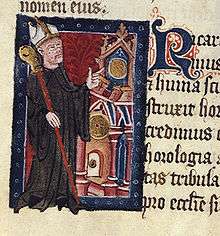Richard of Wallingford
| Richard of Wallingford | |
|---|---|
|
Richard of Wallingford is measuring with a pair of compasses in this 14th-century miniature. | |
| Born |
1292 Wallingford, England |
| Died |
1336 St Albans |
| Occupation | Astronomer, Horologist and Monk |
| Religion | Catholic |
| Parent(s) | Father- a Blacksmith |
- For the Constable of Wallingford Castle, see Richard of Wallingford (constable).[1]
Richard of Wallingford (1292–1336) was a catholic monk and English mathematician who made major contributions to astronomy and horology while serving as abbot of St Albans Abbey in Hertfordshire.
Biography
Richard was born, the son of a blacksmith, at Wallingford in Berkshire (now Oxfordshire) in England in 1292. When he was orphaned he was taken to William de Kirkeby the Prior of Holy Trinity Priory. Richard subsequently spent 6 years studying at Oxford University before becoming a monk at St Albans. He later studied for 9 more years at Oxford. In 1327 he became abbot of St Albans.
Richard of Wallingford is best known for the astronomical clock he designed, while he was abbot, which is described in the Tractatus Horologii Astronomici (1327). The clock was completed about 20 years after Richard's death by William of Walsham but was apparently destroyed during Henry VIII's reformation and the dissolution of St Albans Abbey in 1539. His clock almost certainly was the most complex clock mechanism in existence at the time in the British isles, and one of the most sophisticated ones anywhere. [2]The only other clocklike mechanism of comparable complexity that is documented in the 14th century is the astrarium by Giovanni de Dondi. It gave not just the hours and minutes of the day, but also the tide's ebb and flow as well as the motions of the sun and moon. [3] Based on the 14th-century literary evidence still surviving in the 20th century, several scholars of horological history have tried to build recreations of Richard of Wallingford's clock. The best known of these was built by Haward Horological and for many years was displayed at the Time Museum (now defunct) in Rockford, Illinois; one was built by Eric Watson and is now in the Wallingford Museum, and one built in 1988 is located at St Albans Cathedral.
Richard also designed and constructed calculation devices: a torquetum, the Rectangulus, and an equatorium, which he called Albion. This could be used for astronomical calculations such as lunar, solar and planetary longitudes and could predict eclipses. This is described in the Tractatus Albionis. He published other works on trigonometry, celestial coordinates, astrology, and various religious works.
Richard suffered from what was then thought to be leprosy (although it might have been scrofula or tuberculosis) which he apparently contracted when he went to have his position as abbot of St Albans Abbey confirmed by the Pope at Avignon. He died at St Albans in 1336.
See also
References

- North, J. (2004) God's Clockmaker: Richard of Wallingford and the Invention of Time. Oxbow Books. ISBN 1-85285-451-0
- North, J. (1976) Richard of Wallingford - Volume I Texts and Translations, Volume II - The Life of Richard of Wallingford - Introductions and Commentaries to Text, Volume III - Illustrations, Tables, Appendices, Glossaries, Bibliography and Indexes; An edition of his writings, with introductions, English translation and commentary, Oxford Univ Press. ISBN 0-19-858139-4
- Watson, E (1979) The St Albans Clock of Richard of Wallingford. Antiquarian Horology, Number 4, Volume 11, Summer 1979, p. 372-384.
- "Richard of Wallingford". Retrieved 5 May 2008.
- "Miniature of Richard of Wallingford". Retrieved 5 May 2008.
- "Astronomical Clock, Originally designed by Richard". Retrieved 5 May 2008.
- "The Astronomical Clock of Richard of Wallingford, essay by Nicholas Whyte". Retrieved 1 July 2008.
- "Richard of Wallingford and the Clock of St. Albans, by Deryl Bender". Retrieved 1 July 2008.
- ↑ Richard of Wallingford, abbot and mathematician is not to be confused with the later Richard of Wallingford, constable of Wallingford Castle, and supporter of Wat Tyler in the English peasants' revolt of 1381.
- ↑ Thomas E. Woods Jr., How the Catholic Church Built the Western Civilization, page 36 https://books.google.com.br/books?id=jYvmAgAAQBAJ&lpg=PP1&dq=how%20the%20catholic%20church%20built%20western%20civilization&hl=pt-BR&pg=PA36#v=onepage&q&f=false
- ↑ Durant, Will (1957). The Reformation. The Story of Civilization . 6. Simon and Schuster. p. 242.
External links
- The Wallingford Clock at St Albans Cathedral
- The Astronomical Clock of Richard of Wallingford
- Images of Richard of Wallingford and the Astronomical Clock of Richard of Wallingford from the British Library
- Wallingford History Gateway
- Royal Berkshire History: Richard of Wallingford
